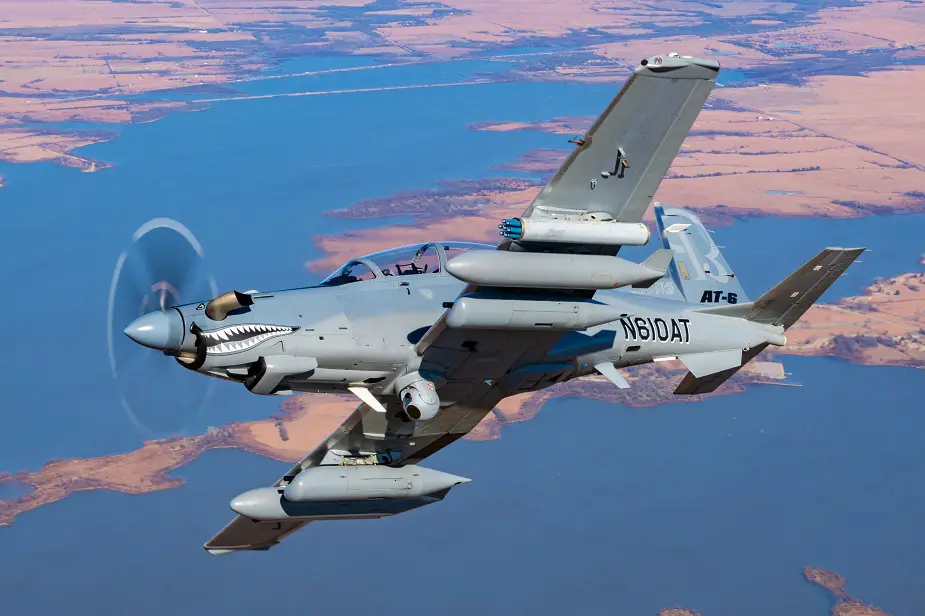Breaking news
Textron Aviation Defense announces $70.2M US Air Force contract award for two Beechcraft AT-6 Wolverine aircraft, training and support services.
Textron Aviation Defense LLC, a Textron Inc. company, announced the finalization of a $70.2 million Other Transaction Authority (OTA) with the U.S. Air Force Life Cycle Management Center to equip the U.S. Air Force with two Beechcraft AT-6 Wolverine aircraft, pilot training, engineering services and up to four years of contractor support for maintenance and spares. The work in support of this OTA, which includes activities in support of military type certification, will take place in Wichita, Kansas.
 Beechcraft AT-6 Wolverine (Picture source: Textron)
Beechcraft AT-6 Wolverine (Picture source: Textron)
The Beechcraft AT-6 Wolverine multi-role turboprop delivers the greatest level of mission configurability, the most advanced ISR technology and the utmost deployability and sustainability. The AT-6 equips operators worldwide with an unparalleled value, ease of training, logistics efficiencies and 85 percent parts commonality with the Beechcraft T-6 Texan II. The AT-6 Wolverine will enter into service at Nellis AFB, Nevada for follow-on light attack experiments by U.S. Air Force, U.S. Marine Corps and partner countries and is available to its sister business unit, Airborne Tactical Advantage Company (ATAC), for contracted air services under the U.S. Navy’s Terminal Attack Controller Trainer (TACT) program for live-air training of forward air controllers (FACs), joint terminal attack controllers (JTACs) and forward air controllers (airborne) at NAS Fallon, Nevada. The AT-6 Wolverine features 35 weapons configurations that fulfill SOCOM Armed Overwatch requirements for Close Air Support (CAS), Armed Intelligence, Surveillance & Reconnaissance (ISR), Strike Coordination & Reconnaissance (SCAR), and Forward Air Control (Airborne) (FAC(A)).
“Textron Aviation Defense is proud to equip the U.S. Air Force with the multi-role Beechcraft AT-6 Wolverine,” said Brett Pierson, vice president of Defense Strategy and Sales. “The AT-6 is a vital element of the National Defense Strategy to build ally and partner capacity, capability and interoperability — and does so at a fraction of the cost of other combat aircraft. We’re eager to deliver the aircraft to the Air Force in support of Air Combat Command’s (ACC) development of operational tactics and standards for exportable, tactical networks that improve interoperability with international partners.”
This acquisition enables the U.S. Air Force to leverage a commercial off-the-shelf, non-developmental integrated weapons system to equip a multi-national coalition with a common system that meets a wide array of training and operational requirements. An affordable solution, the AT-6 cost per flying hour is less than $1,000 and its small maintenance footprint — as demonstrated during both phases of the Light Attack experiment — underscore the aircraft’s cost-effectiveness, deployability and sustainability.
“Our focus is on how a light attack aircraft can help our allies and partners as they confront violent extremism and conduct operations within their borders,” said Air Force Chief of Staff Gen. David L. Goldfein in a U.S. Air Force press release published upon the issuance of the request for proposal. “Continuing this experiment, using the authorities Congress has provided, gives us the opportunity to put a small number of aircraft through the paces and work with partner nations on ways in which smaller, affordable aircraft like these can support their air forces.”
ACC will experiment with the AT-6 to further examine the ways in which a common architecture and intelligence-sharing network will connect platforms, sensors and weapons and deliver a digital network for light attack aircraft.
“It’s rewarding to equip U.S. and partner nations with an affordable, easy to maintain and highly effective tactical aircraft in this era of constrained military budgets,” Pierson added. “The U.S. Air Force and Navy flew the AT-6 during the Light Attack experiment, putting its combat-proven A-10 mission computer, Wescam MX-15 EO/IR sensor, Airborne Extensible Relay Over-Horizon Network (AERONet) and other capabilities to work, employing a substantial amount of ordnance, demonstrating aircrew re-fueling and re-arming at the Forward Arming and Refueling Point (FARP) and conducting other activities in support of experiment objectives. The AT-6 met all of the experiment’s standards and proved itself as a high performance, austere field-capable aircraft that delivers unparalleled mission capability, deployability and sustainability."



















